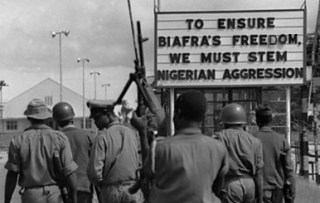 |
| Nigerian Troops approaching the Biafran territory |
BIAFRA REMEMBERED
During August, 2017 I was contacted by someone from the intelligence community who was drafting a a study: ANALYSIS: POTENTIAL USES OF LIGHT CIVILIAN AIRCRAFT IN MINI-COUNTER INSURGENCY (MINI-COIN) ROLES
He had found my Biafran action among some dusty files and asked for details of what had actually happened. This guy had tried to convince decision-makers expensive, sophisticated weapons weren’t required to counteract small threats. Everyone should be remember people in Viet Nam complaining about using multi-million dollar F-4s to destroy bicycles.
His first e-mail contact to me said, in part:
“ .….. the idea that we would release half-million-dollar weapons—or more—against hostiles in battered pickups that they traded for a goat is astounding. Certainly such things can be done, but it is tantamount to using a shotgun to kill a fly.”
I pointed out to the planners at USNORTHCOM the example of your Biafran squadron, and they were rather amazed that simple light sport aircraft—with no advanced electronics, no GPS-guided munitions, nothing whatsoever that resembles the high-tech approach of an F-22 or F-35—were able to take on a decently-funded Russian-supported air force with MiG fighters and Ilyushin bombers, and show the world that all of that advanced approach ultimately meant nothing. Using the Malmo MFI-9 aircraft, your squadron destroyed half of the Nigerian bomber force, and a disconcertingly high number of MiG fighters.”
*****
And so I wrote the story for him to include in his study.
I have never publicly revealed details about my involvement, since I “never existed.” Over the years, I operated in this theater, and others, as an anonymous figure, code named Shadow.
The actual story is somewhat more complicated than reported. Major power centers - governmental and commercial - were in play behind the scenes as Biafra became a break-away state, looking for recognition.
Perhaps these shadowy forces were instrumental in the final decision of Ojukwu to act. There were huge dollar amounts in petroleum involved. Countless people’s lives were at risk.
“There was the port. It was blockaded by a War Two corvette crewed by local sailors with ex-RN officers. The corvette was protected by a torpedo net. The boat was preventing tankers from loading at a refinery.”
| Mercenaries refitting a Biafran Invader B-29 medium bomber |
The USAF was eager to assist and offered 4 Boeing C-97 transports for a project that would be coordinated by Russ O’Quinn. Russ was an ex-USAF pilot who went on to test-fly for Douglas before creating his own civilian test unit - FLIGHT TEST RESEARCH in San Diego, Califonia. I sold Russ 2 Canadair F-86 for his unit.
The tide was already beginning to turn against the break-away state and my corvette plan soon became redundant as Port Harcourt passed into the federal government’s hands.
| The entire Biafran Air Force are briefed by its commander, count Carl Gustaf von Rosen, just before a mission, Biafra (Nigeria) 1969. |
As the conflict progressed, MIG-17s and IL-28s, with Czech and East German pilots became a dangerous factor during daylight and nocturnal periods. Subsequent conversations with Colonel Ojukwu and Count Gustaf von Rosen saw us discussing the MIG threat and what could be done. One of my Canadian associates, Roy Farran, had pioneered armed jeep units for the Special Air Service, during World War Two. Roy would tell the story in his book, “Winged Dagger.” I suggested this concept. (Rolf Steiner would carry out jeep attacks a year later.)
| Installing a SNEB 68mm Matra rocket |


As soon as I observed this web site I went on reddit to share some of the love with them.